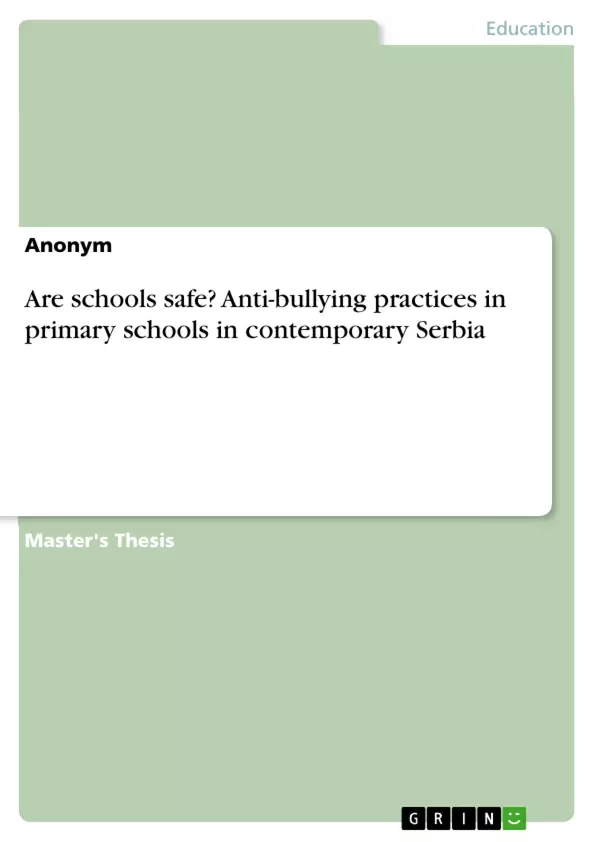The issue discussed in this paper is the problem of school bullying at primary schools in the Republic of Serbia as it is proven to grow as an increasing phenomenon. Specifically, attention is given to anti-bullying practices in primary schools in order to analyze if children are free from violence, abuse and neglect. The central research question of the research is why bullying is an issue in Serbia and what the responsiveness of public authorities tackling this issue is, therefore including the accountability of primary schools in Serbia, the responsibility of the educational system for tackling bullying, the measures implemented by teachers/educators.
To answer these questions, the paper presents the international and national legislative framework, a theoretical discussion of bullying as a socio-cultural phenomenon, together with a list of key events which stirred the general public and a survey. The study concludes that bullying is an issue in contemporary Serbia because of overall socio-economic conditions in Serbia, lack of expert associates within schools, inadequate prevention and intervention measures, and necessary amendments of the current legislation. Also, the research confirms the initial hypothesis by which current anti-bullying practices in primary schools in Serbia do not stand for effective response and adequate measures to prevent and reduce school bullying.
Inhaltsverzeichnis (Table of Contents)
- Introduction
- 1. Theoretical framework
- 1.1. What is bullying?
- 1.1.1. Malign and non-malign bullying
- 1.2. Why children and adolescents become aggressive?
- 1.3. Why tackling bullying is so complex?
- 2. Anti-bullying practices in Serbia
- 2.1. International framework
- 2.2. National legislative framework
- 2.3. National institutional bodies and instruments
- 3. Anti-bullying practices in Serbia ‘de facto’
- 3.1. Bullying as socio-cultural phenomenon
- 3.2. Key events; the public call for action in Serbia
- 3.3. Teaching staff in Serbia vs. bullying; the survey
- Conclusion
Zielsetzung und Themenschwerpunkte (Objectives and Key Themes)
This paper examines the problem of school bullying in primary schools in the Republic of Serbia, focusing on anti-bullying practices and their effectiveness in protecting children from violence, abuse, and neglect. The primary research question is why bullying is an issue in Serbia and what measures are being taken to address it. The study explores the accountability of schools, the role of the educational system, and the measures implemented by teachers/educators.
- The prevalence and impact of bullying in Serbia
- The effectiveness of existing anti-bullying practices
- The legal framework and its limitations in protecting children from bullying
- The role of cultural factors and socio-economic conditions in contributing to bullying
- The importance of teacher education and the role of experts in addressing bullying.
Zusammenfassung der Kapitel (Chapter Summaries)
- Introduction: Provides an overview of school bullying as a global phenomenon and highlights its prevalence in Serbia, with statistics and examples illustrating its impact on children's well-being and right to education. The central research question and working hypothesis are introduced, and the research methodology is outlined.
- 1. Theoretical Framework: Presents key theories and definitions related to bullying, including its types, causes, and the complexities involved in tackling it. It explores factors that contribute to aggression in children and adolescents, such as family dynamics, socio-economic status, and social cognition.
- 2. Anti-bullying Practices in Serbia: Examines Serbia's anti-bullying practices across three frameworks: international, national legislation, and national institutional bodies/instruments. It analyzes relevant international conventions and national laws related to children's rights and the right to education, highlighting Serbia's obligations and the existing legal framework.
- 3. Anti-bullying Practices in Serbia ‘de facto’: Explores bullying as a socio-cultural phenomenon in Serbia, examining the influence of cultural traditions, post-conflict trauma, and socio-economic factors. It delves into key events that have raised public awareness about bullying, including the tragic case of Aleksa Jankovic, and discusses potential solutions for addressing the issue, such as Aleksa's Law. Additionally, a survey of teachers and educators in Serbia provides insights into their awareness, training, and the challenges they face in tackling bullying in schools.
Schlüsselwörter (Keywords)
Bullying, Serbia, anti-bullying practices, school violence, child protection, right to education, legal framework, socio-cultural phenomenon, key events, Aleksa's Law, teacher education, expert associates, intervention measures, prevention programs.
- Arbeit zitieren
- Anonym (Autor:in), 2016, Are schools safe? Anti-bullying practices in primary schools in contemporary Serbia, München, GRIN Verlag, https://www.grin.com/document/353794



